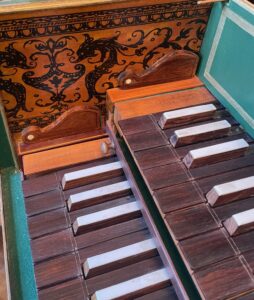Zuckermann after Flemish Models, 1990
Description

| Date: | 1990 |
| Origin: | Hamburg |
| Serialnumber: | --- |
The Flemish harpsichord is a significant variation of the harpsichord that was developed primarily during the Renaissance and Baroque periods in the Netherlands, particularly in Flanders. It is distinguished by its tonal and visual characteristics, setting it apart from other regional types, such as the Italian or French harpsichord. Flemish harpsichords were crafted by renowned workshops, including the famous Ruckers family in Antwerp, who were active from the late 16th to early 18th centuries. Their instruments are considered masterpieces of harpsichord construction. Flemish harpsichords are known for their rich, warm sound, often described as “singing.” This was achieved through specific construction techniques:
- Soundboard: Typically made of spruce, the soundboard is crucial for tonal quality.
- Double manual design: Many Flemish harpsichords feature double manuals, allowing performers to switch between different tonal colours or dynamics.
- String length: Flemish harpsichords often have longer string lengths, contributing to their powerful sound.
Flemish harpsichords are also famous for their rich decoration and painting. The outer casings were often adorned with intricate paintings or marbling, while the inner lid was decorated with floral patterns or biblical scenes. The interior of the instruments was frequently lined with fine wallpaper.
The instruments crafted by Flemish builders significantly influenced music and harpsichord construction throughout Europe. Many Baroque composers valued these instruments for their balanced and clear tone. Furthermore, Flemish harpsichords served as models for later French instruments, which developed these designs further.
Today, Flemish harpsichords are often used as templates for reproductions, as they are considered quintessential Baroque harpsichords.

Flemish Harpsichord by W. Zuckermann – Eric Feller Collection
This double–manual harpsichord, based on Flemish models, comes from the Wolfgang Zuckermann workshop and was built in 1990. It is constructed in a historically authentic manner. The case, in a rectangular grand-piano shape, is made of cedarwood and features ornate brass hinges. It is painted green with gilded panels and leather inlays on both the outer and inner lid. The keyboard is made of rosewood, and Flemish wallpaper is affixed around the keyboard and the interior casing. The spruce soundboard is painted and features a carved central rose. The instrument has three registers (8’, 8’, 4’), a double lute stop, a coupler, three rows of plastic jacks, and Delrin plectra. It also includes a manual register stop for engaging the 4’ register and a lute stop, which can be activated for both 8’ registers on both manuals. The harpsichord rests on a decorated stand. Its sound is dark, resonant, and lyrical, with a wide range of tonal colours.

Keyboard and Flemish decoration – Eric Feller Collection
With the rise of historical performance practice, the demand for such instruments increased. Companies like Neupert and Sperrhake predominantly produced harpsichords using the modern “Rastenbauweise” (frame construction method), which combined many elements of modern piano construction but had little in common with historical harpsichords or their sound. Authentic copies were relatively rare and very expensive. Wolfgang Zuckermann identified this gap in the market and began offering affordable harpsichord kits constructed in a historically accurate manner in the late 1950s in the United States. These kits were available in various levels of completion, allowing customers to build their own harpsichord at a relatively low cost. However, these self-built harpsichords always reflected the skill of their builders.
Wolfgang Zuckermann was born on October 11, 1922, in Berlin. Due to his family’s Jewish faith, he fled to the United States with his parents in 1938. After training as a child psychologist, he became involved in harpsichord construction and began selling harpsichord kits inspired by historical originals in the 1950s. In 1969, he sold his company (which still operates worldwide today under various names) and moved to England. In 1995, he relocated to France and lived in Avignon. He authored two books on harpsichord construction:
- The Modern Harpsichord (1969, October House)
- The Modern Harpsichord: Twentieth Century Instruments and Their Makers (1986, Reprint Services Corp)
Wolfgang Zuckermann passed away on November 3, 2018.
| Length: | 226 cm |
| Width: | 94 cm |
| Height: | 25,5 cm |
| Circumference: | 5 octaves (FF – f3) |
| Mechanics: | plastic jacks with delrin quills |
| Pedals: | Registers: 8’, 8’, 4’, double lute, 2 manuals |
| Signature: | --- |

